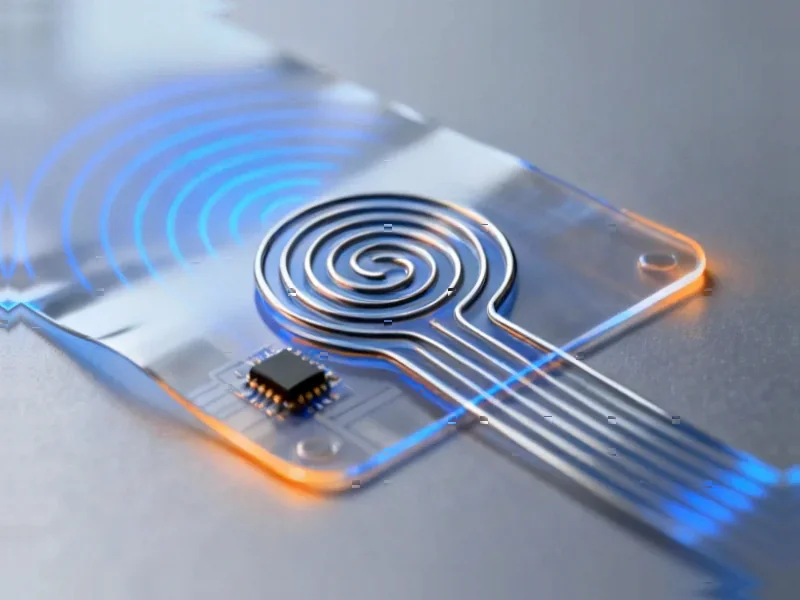Flexible Ultrasound Technology Breakthrough
Researchers have developed a novel flexible ultrasound technology that maintains electrical and acoustic characteristics even after extensive bending, according to a recent report published in npj Flexible Electronics. The flexible transducer array with statically adjustable curvature represents a significant advancement for therapeutic applications, particularly in anti-inflammatory treatment.
Table of Contents
Innovative Design and Fabrication
Sources indicate the technology utilizes Flexible Tile-and-Ridge (FTR) Capacitive Micromachined Ultrasonic Transducer (CMUT) structures that combine rigid acoustic elements with flexible elastomer-filled spacings. The report states that each CMUT element maintains traditional rigid construction using single-crystal silicon membranes suspended over vacuum cavities, while the spaces between elements are filled with elastomer to provide flexibility.
Analysts suggest the key innovation lies in the wafer-scale fabrication process that eliminates rigid bridges between elements. The manufacturing approach reportedly uses tetramethylammonium hydroxide (TMAH) for anisotropic wet etching of silicon wafers, creating trapezoidal gaps between elements that enable both inward and outward bending without damaging the rigid structures. According to the research, these trapezoidal gaps measured between 70.8 and 412.6 micrometers depending on mask opening size.
Durability and Performance Validation
The devices demonstrated remarkable durability during testing, the report states. After 100 bending cycles with a curvature radius of 2.5 millimeters, the center frequency remained within 99% of the original value. Electrical impedance measurements showed no significant changes due to bending, indicating robust mechanical design.
Acoustic performance testing revealed a center frequency of 3.43 MHz in oil with a -3 dB fractional bandwidth of 113%, significantly wider than typical piezoelectric transducers. The report indicates this broad bandwidth is particularly advantageous for therapeutic applications where varying frequencies may be needed to study different biological effects.
Output pressure reached 197 kPa with pressure sensitivities of 12.47 kPa/V, according to measurements taken 20 millimeters from the transducer array. The technology maintained consistent acoustic pressure over four consecutive days of immersion testing without performance degradation.
Curvature Control Mechanism
Researchers devised an innovative method for controlling and fixing curvature using Low-Melting-Point Alloy (LMPA), sources indicate. By applying DC voltage to generate Joule heating in the LMPA, the curvature can be modified when the alloy melts at 47.2°C, then fixed when it solidifies upon cooling.
The report states that phase transition from solid to liquid occurred at approximately 2.1 volts, with higher voltages reducing the time required for transition. At 3 volts, device modulation was achieved within an average of 9 seconds, stabilizing around 12 seconds after the change. The maximum bending angle is reportedly approximately 45 degrees, limited by factors including passivation layer thickness and element pitch.
Therapeutic Application Demonstration
Perhaps most significantly, the technology successfully demonstrated therapeutic potential through in vivo ultrasound stimulation of mouse spleens, according to the research. The 1D CMUT arrays provided sufficient coverage of the mouse spleen and curvature for abnormal regions.
The report indicates that ultrasound stimulation suppressed autoimmune cells such as T and B cells secreted from macrophages, leading to alleviation of rheumatoid arthritis symptoms. Behavioral experiments confirmed the treatment effectiveness, suggesting potential for long-term therapeutic applications.
Beam Focusing Capabilities
Testing revealed that bending state significantly affects ultrasound beam patterns, analysts suggest. In flat states, ultrasound beams showed no specific focusing, while inner bending states concentrated beams at focal points. When comparing 90-degree to 30-degree status at the focal point, the axial resolution was reportedly five times smaller and maximum pressure 1.6 times higher in more curved configurations.
Outer bending states dispersed ultrasound beams as expected. These sensitive changes in beam patterns highlight the importance of controllable curvature in flexible ultrasound transducers for targeted therapeutic applications.
Future Implications
The successful demonstration of this technology opens new possibilities for conformal ultrasound devices that can adapt to various body contours while maintaining precise acoustic control. The research suggests potential applications beyond anti-inflammatory treatment, including other therapeutic ultrasound applications requiring customized curvature and reliable long-term performance.
According to the report, the fabrication technology also enabled creation of various shapes including planes, cubes, and closed flowers, demonstrating versatility for covering both 2D surfaces and complex 3D targets. This flexibility, combined with electrically adjustable curvature, represents a significant step forward in wearable therapeutic ultrasound technology.
Related Articles You May Find Interesting
- Pixel Camera App Crashes on De-Googled Android Over Font Dependency
- Microsoft Explores On-Premises AI Integration for Exchange Server Amid Data Priv
- European Aerospace Giants Forge Alliance to Compete in Global Space Race
- IBM’s $9.5 Billion AI Pipeline Fuels Triple-Digit Growth Across Core Business Se
- Spring AI MCP Framework Enables Natural Language Database Queries Through Java I
References
- http://en.wikipedia.org/wiki/Capacitive_micromachined_ultrasonic_transducer
- http://en.wikipedia.org/wiki/FTR_(professional_wrestling)
- http://en.wikipedia.org/wiki/Substrate_(chemistry)
- http://en.wikipedia.org/wiki/Professional_wrestling_double-team_maneuvers
- http://en.wikipedia.org/wiki/Trapezoid
This article aggregates information from publicly available sources. All trademarks and copyrights belong to their respective owners.
Note: Featured image is for illustrative purposes only and does not represent any specific product, service, or entity mentioned in this article.



